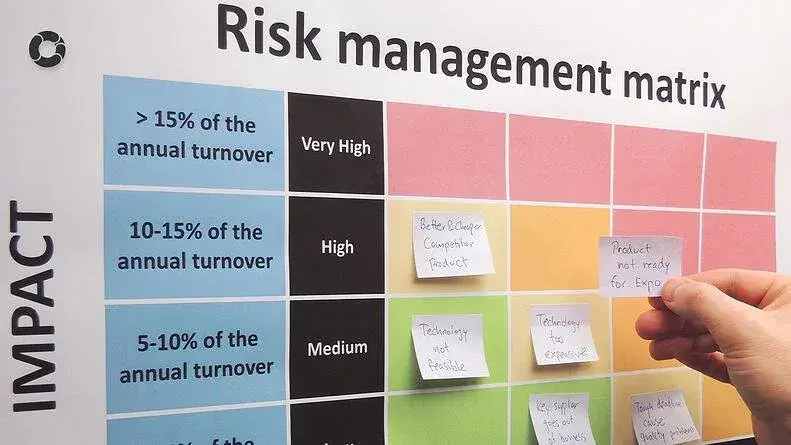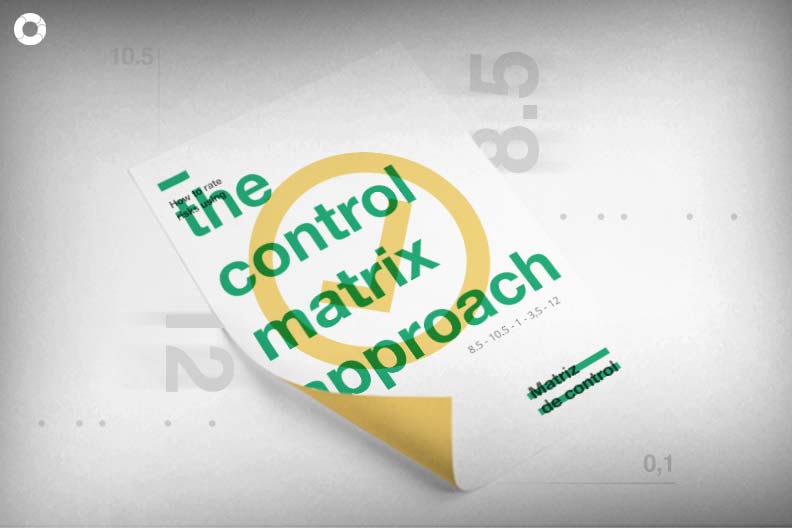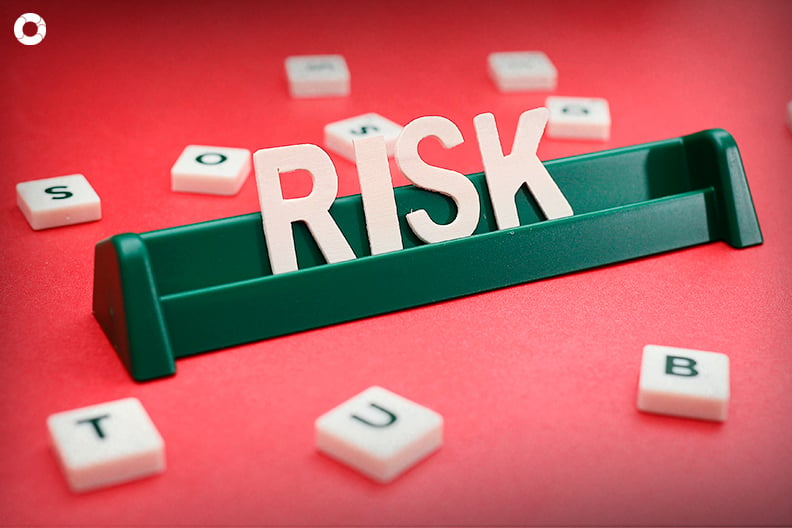Main types of risk that can affect a company

Regardless of industry or size, every organization faces potential risks that can disrupt its operations and threaten its stability. Identifying, understanding, and managing these risks are key parts of risk management. In this guide, we’ll explore the main types of risks that can impact companies and how a risk matrix can be instrumental in organizing and addressing them.
The risk matrix is a vital tool in risk management, providing a visual framework for classifying and evaluating risks based on their likelihood and impact. Let’s break down the most common categories of risks and see how each type can be mapped, managed, and mitigated.
Risk is generally defined as the uncertainty surrounding the achievement of an objective. This uncertainty can cause unexpected consequences, affecting an organization’s processes, operations, reputation, legal standing, and financial stability. Risks can arise in any area of a business, and classifying them based on their characteristics and potential impact makes it easier to assign responsibility and address them effectively.
A risk matrix offers a structured way to visualize and prioritize these risks, guiding organizations to focus on high-priority threats while monitoring those that are lower in probability or impact. Below, we briefly explain each of these.
1. Financial Risk
Financial risk is directly linked to the financial health and stability of a company. It encompasses risks related to cash flow, investments, credit, and more. Common types of financial risk include:
- Credit Risk: The risk that customers or counterparties will default on financial obligations, causing cash flow disruptions and financial losses.
- Currency Risk: Exposure to losses from fluctuations in foreign exchange rates, affecting multinational businesses or those with significant international trade.
- Liquidity Risk: The danger that a company may not be able to meet short-term obligations due to insufficient liquid assets, potentially resulting in insolvency.
- Interest Rate Risk: The impact of interest rate changes on the company’s finances, which can affect the cost of borrowing or the value of fixed-income investments.
- Market Risk: This includes potential losses due to fluctuations in market conditions or asset values, often impacting companies with significant investments in equities, commodities, or other financial assets.
Using a risk matrix, companies can categorize financial risks based on probability and impact, allowing them to focus on high-impact areas like credit and liquidity risks that can severely affect cash flow and stability.
2. Legal Risks
Legal risks arise from regulatory and compliance requirements that companies must follow to operate legally. These risks may include potential violations of laws, regulations, or internal policies that can lead to penalties, fines, or reputational damage. Legal risks vary widely depending on location, industry, and regulatory environment. Some common legal risks include:
- Compliance Risk: The risk of failing to comply with regulations or industry standards, which can lead to financial and reputational harm.
- Contractual Risk: Issues arising from poorly defined or breached contracts, which could lead to litigation or financial losses.
- Intellectual Property Risk: Infringements on intellectual property rights or the unauthorized use of proprietary technology or branding.
Incorporating these risks into a risk matrix enables organizations to prioritize compliance-related risks and focus on mitigating those with the highest probability and impact.
3. Environmental Risks
Environmental risks can be natural or social, with both having potential implications for business operations and public perception. Organizations must understand and prepare for environmental risks as part of their risk management strategy. Key types include:
- Natural Environmental Risks: These include natural disasters such as earthquakes, floods, or extreme weather events that can disrupt operations, cause asset damage, or endanger personnel.
- Social Environmental Risks: Social risks can arise from issues related to inclusivity, discrimination, and other socially sensitive topics. These risks, if not managed, can damage the company’s reputation and relationship with stakeholders.
Because many environmental risks are outside the organization’s direct control, proactive strategies—such as awareness campaigns, emergency response plans, and community engagement—are essential for mitigation. Mapping these risks in a risk matrix allows companies to identify high-probability natural risks or high-impact social risks, providing insights on where to allocate resources.
4. Political Risks
Political risks are influenced by government actions, regulatory changes, or political instability. These risks often affect companies operating in or trading with foreign markets. Key categories include:
- Governmental Risks: Changes in regulations, tax policies, or economic reforms can directly impact a company’s operational framework and financial performance.
- Legal and Extra-legal Risks: Terrorist activities, revolutions, or civil unrest can disrupt business operations, making this a high-impact category of political risk.
To prepare for political risks, companies should remain informed about local and global political climates. They can use a risk matrix to evaluate the probability and impact of political changes, helping them determine when to adopt additional measures, such as establishing political risk insurance or diversifying their market presence.
5. Economic Risks
Economic risk refers to the potential for financial losses resulting from fluctuations in the broader economy. These risks are both internal and external, encompassing everything from recession to inflation. Economic risks often include:
- Market Demand Changes: Variations in consumer demand or spending habits can affect sales, especially during economic downturns.
- Supply Chain Disruptions: Economic challenges can affect suppliers’ ability to deliver goods and services, impacting the company’s operational efficiency.
- Credit Constraints: Limited access to capital due to changes in interest rates or lender requirements can limit growth and operational capacity.
When applied to a risk matrix, economic risks allow organizations to prioritize those most likely to affect revenue, supply chains, and financial health.
Distinguishing Pure Risks from Speculative Risks
When analyzing risks, it’s helpful to differentiate between pure risks and speculative risks. This distinction provides a clearer understanding of the type of uncertainty an organization may face.
-
Pure Risks: These risks involve situations where only a loss (or no loss) can occur, with no opportunity for gain. Pure risks often stem from damage or loss to property, health, or security. For example, natural disasters represent pure risks, as they can only result in harm rather than financial gain.
-
Speculative Risks: Speculative risks, on the other hand, involve uncertainty that could lead to either a gain or a loss. For example, investing in the stock market is a speculative risk, as it offers profit potential but also exposes the investor to possible losses.
Both types of risks are essential considerations in risk management. A risk matrix can help organizations categorize pure and speculative risks according to probability and impact, guiding them in devising appropriate strategies for each type.
Why a Risk Matrix is Essential in Risk Management
A risk matrix is a visual tool that helps organizations assess risks by mapping them based on two critical dimensions: likelihood and impact. This matrix enables decision-makers to categorize risks into manageable levels and prioritize actions. By assessing where each risk type falls within the matrix, organizations can effectively allocate resources to address high probability and high-impact risks.
The risk matrix provides valuable insights that drive decisions regarding:
- Risk Mitigation Strategies: Helps determine whether to avoid, transfer, reduce, or accept specific risks.
- Resource Allocation: Guides where resources should be directed to address the most significant risks.
- Monitoring and Reporting: Enables continuous monitoring and adjustments based on risk levels, improving overall risk management processes.
Implementing Risk Management with Software Solutions
Using risk management software, like Pirani Risk, can greatly simplify the process of building and maintaining a risk management framework. Tools like these provide centralized platforms to identify, measure, control, and monitor risks. They also allow for real-time updates, which makes managing risks in a dynamic environment more efficient and effective.
With Pirani Risk, companies can structure their risk management approach around a risk matrix, setting clear parameters for each risk category and establishing routines for reporting and response. This leads to faster identification of high-priority risks, improved compliance, and a stronger ability to prevent or mitigate risks before they materialize.
While every company will experience different types and levels of risk, a clear understanding of each risk category, combined with effective tools like a risk matrix, can strengthen an organization’s ability to manage uncertainty. A well-implemented risk management system helps companies remain resilient, proactive, and prepared to navigate challenges in an increasingly complex business environment.
You May Also Like
These Related Stories

Excel Matrix vs. Risk Management Software: Which is better?

Heat map: a tool to optimize risk management

How to rate risks using the control matrix approach

What is risk appetite?

Risk management for software projects




No Comments Yet
Let us know what you think